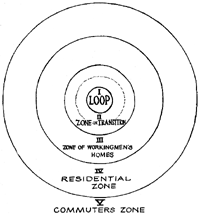5.8. The Chicago School
Brian Fedorek
Biological and psychological positivism looked at the differences between criminals and non-criminals. Instead of finding differences between kinds of people, the Chicago School tried to detect differences between kinds of places. During the 1920-1930s, the University of Chicago was the vanguard for human ecology, which is the study of the relationship between humans and their environment. Robert Park (1925) viewed cities as “super-organisms,” comparing the city-human relationship to the natural ecosystems of plants and animals that share habitats. Furthermore, Burgess (1925) proposed concentric zone theory, which explained how cities grow – from the central business district outwards.[1]

Shaw and McKay (1942), who were both former students of Burgess, began to plot the addresses of juvenile court-referred male youths. They noticed many of the addresses were located in the zone in transition.[2] Upon further investigation, Shaw and McKay noticed three qualitative differences in the transitional zone compared to other zones. First, the physical status included the invasion of industry and the largest number of condemned buildings. When many buildings are in disrepair, population levels decrease. Second, the population composition was also different. The zone in transition had higher concentrations of foreign-born and African-American heads of families. It also had a transient population. Third, the transitional zone had socioeconomic differences with the highest rates of welfare, lowest median rent, and the lowest percentage of family-owned houses. Interrelated, the zone also had the highest rates of infant deaths, tuberculosis, and mental illness.
Shaw and McKay believed the zone in transition led to social disorganization. Social disorganization is the inability of social institutions to control an individual’s behavior. Since the zone in transition had people moving in and moving out at such high rates, social institutions (like family, school, religion, government, and economy) and members could no longer agree on essential norms and values. As earlier stated, many residents were foreign. Thus, speaking different languages and having different religious beliefs may have prevented neighbors from talking to one another and solidifying community bonds. Overall, Shaw and McKay were two of the first theorists to put forth the premise that community characteristics matter when discussing criminal behavior.

